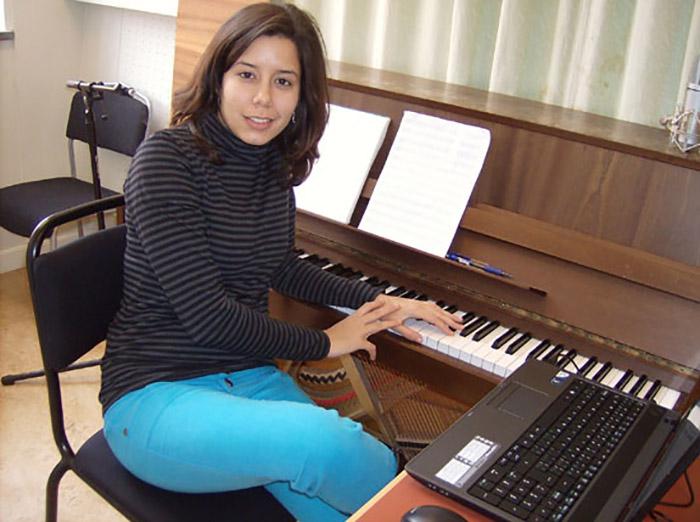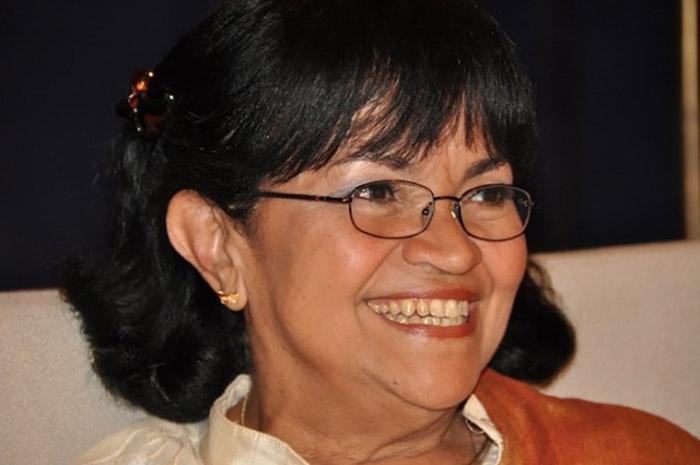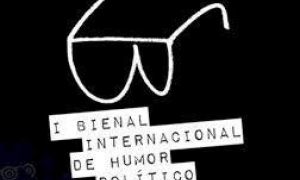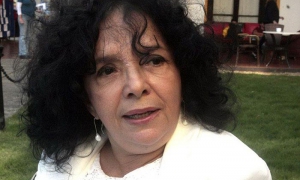
The Corhabana Festival is an enriching experience. The quality of participating national and international vocal groups, as well as the works presented is impressive. The premiers of several Cuban choral pieces are not the least important of these elements.
This year, Maestra Digna Guerra, president of the choral celebration's 12th edition (June 28 - July 2) selected the work Canción, by the young composer Wilma Alba to close the event in the National Theater's Avellaneda Hall.
“It is a beautiful work by a young composer who is doing marvelous things," explained Guerra, also the director of the National Choir of Cuba, the Entrevoces group, and her own children's choir.
The Maestra no doubt took into consideration that this year's festival is dedicated to children and youth, and managed to organize 10 children's choirs, for a total of over 300 children, to premier Canción, accompanied by the National Concert Band, sure to be a singular performance.
We spoke with Wilma Alba (Havana, 1988) at the National Choir's headquarters in the Havana neighborhood of Vedado, to address the many aspects of her work, which includes compositions for chamber choirs, choral versions, electronic and symphonic music, and even sound tracks for theater and film.

Her compositions have been performed during important events such as Havana's Contemporary Music Festival; the 12th International Choir Symposium in Marktoberdorf and Harmonie, both in Germany; the world choir event America Cantat 7 in Colombia, 2013; festivals in Santiago de Cuba and the chamber music festival "A tempo con Caturla" in Villa Clara; and the 2014 Leo Brouwer Chamber Music event; plus she premiered Pregón during the Voix Humaines organized by Leo Brouwer's office.
Choirs with long traditions have included her work in their repertories, among Cuban groups: the National, Entrevoces, Vocal Leo, Ensemble Vocal Luna and the Ventus Habana quintet; and among those abroad: the Gunno Palmqvist Music and Drama Academy's Chamber Choir, at the University of Gothenburg in Sweden; JOCONDE14 and the National Youth Choir in Spain; and Alea 21 based at Puerto Rico's conservatory.
First let’s talk about your educational background…
I studied choral conducting at the Guillermo Tomás Conservatory, with Professor Corina Campos, director of the group Vocal Leo, and composition with Professor Juan Piñera at the Higher Institute of Art (ISA).
Is choral music always your number one focus?

Pretty much. Choral music is central to my career as a composer, because since the age of nine, when I was in fifth grade, I started to sing in choirs and study the genre, and I began to develop a passion for it. When I decided to try my hand at composition it was based on my experience with choral music arrangements. I wanted to try to adapt works to choral format for the groups I was working with, and that’s how it all came about. I like vocal work. Today composing is an essential part of my life.
Talk to us about Canción…
It was a call to many choral groups and professional musicians who are going to premier the work. Over 300 children and 70 musicians. The musical-score will be sung by our children’s choirs accompanied by the National Concert Band. That’s how the piece is set out, an original part by myself using text by Nersys Felipe and José Martí and other compositions by Teresita Fernández and Silvio Rodríguez.
Your participation in Corhabana 2016 has been extensive…
I’ve been lucky. Not only with the premier of Canción, which is something huge and delightful, but also in the Iglesia de Paula, where the Entrevoces children’s choir directed by Maestra Digna Guerra, performed one of my works from their repertory, “Suite infantil” a composition for a children’s choir, piano and string quartet. From another one of my collections - Cinco canciones para coro mixto a capella – they selected “Pórtico” and “El canto quiere ser dos.”
Electro-acoustic music is also an important genre in your work…
Cuba has a tradition of this type of music dating back to the 1980s with composers such asJuan Blanco, Roberto Valera, Carlos Fariñas, Edesio Alejandro, and my Professor Juan Piñera. We studied electro-acoustic composition at ISA and I focused on the element linked to concert music. In 2012, I was awarded a scholarship by the University of Gothenburg’s Academy of Drama and Music in Sweden, where I developed my work even further with the software available there. Later I created my first electro-acoustic piece, “Transfiguraciones”through the Conmutaciones scholarship program awarded by the Asociación Hermanos Saíz (AHS).
How would you describe the choral movement in Cuba today?
It is very strong, despite the fact there aren’t many composers who write for choirs, which I believe is due to the need for choral conducting training. There is a lack of new arrangements, new works. The choral movement itself is very high quality, it's well respected. If we compare it to that of other countries, in Cuba the level of sound quality, the repertories, the voices, even the way in which the movement is institutionalized, is excellent.
Here it features within the sphere of concert music which enables it to benefit from professional choral singers, while in other countries choral groups are composed of amateurs. The movement is also of a very high level with great conductors such as Maestras Digna Guerra, María Felicia Pérez (Coro Exaudi), Alina Orraca (Schola Cantorum Coralina), and Corina Campos (Vocal Leo), all highly trained, and who have dedicated many years to consolidating this work.
What is the impact of an event such as Corhabana?
In my personal case, I feel like it nurtures my work with the choral groups, and motivates me to compose. Generally speaking its an enriching experience, singing in a choir is amazing, it gives you lot of positive energy, its not the same when someone sits down to play an instrument and when they sing, one communicates on a more human level, more directly with the audience. It’s a message, an idea, a word. For me it has a unique magic.
12TH EDITION OF THE INTERNATIONAL CORHABANA FESTIVAL
A celebration of choral music
Maestra Digna Guerra, president of the International Corhabana Festival organizing committee noted that the 12th edition of the event (June 28-July 2), is dedicated to children’s and youth chorals.
Sponsored by the Cuban Music Institute’s National Center for Concert Music, the Festival takes place every two years, and is always dedicated to a specific specialty and with guests from all the country’s provinces and various other nations.
In this sense she noted that eight professional chorals from Havana (National Choir of Cuba, Exaudi, Entrevoces, D´Profundis, Schola Cantorum Coralina, Camerata Sine Nomine, Vocal Leo and Vocal Luna), are scheduled to paticipate, as well as groups from the country’s provinces such as Orfeón Santiago and the Euterpe choir from Las Tunas.
No less than 19 children’s and three youth choirs have been brought together for this special occasion which, in addition to their programmed concerts, will all participate in the performance, during the Festival closing ceremony, of Canción by Wilma Alba, and Vivaldi’s Gloria en Re Mayor RV 589, according to Guerra, also National Prize for Music winner.
“Gloria will be performed by the Havana Chamber Orchestra directed by Daiana García and Maestro Guido López Gavilán’s Música Eterna Chamber Orchestra, with solos by three female singers, winners at the Ravinia festival in the U.S. – affiliated with the Cuba Chamber Music Festival and now also Corhabana – all under the baton of German conductor, Thomas Gavrich.
The festival has invited four international choirs to participate: The Chicago Children’s Choir and Cantigas Choir (both from the U.S.), Juárez City Autonomous University Choir (Mexico) and Vocal Art Ensemble (Colombia).
During a press conference at the National Choir of Cuba’s headquarters, the Maestra announced that scheduled to take place are 22 concerts held across the capital’s main event spaces, including the National Theater; Basílica Menor de San Francisco de Asís; Oratorio San Felipe Neri; Iglesia de Paula; Hispano-American Cultural Center and National Museum of Fine Arts’ Arte Universal building.
Guerra added that given that the event is focused on children’s choirs, the customary festival workshops will be dedicated to children’s choir repertories, and led by maestra Luimar Arismendi, from Venezuela; traditional children’s songs by Cuba’s Nelly Cañizares, as well as spiritual and gospel music, by maestro Robert Chapman (U.S.).
Finally, according to Maestra Digna Guerra, Corhabana 2016 is an important space in which to celebrate the island’s choral movement, while 1961 was a key year for the creation and development of Cuba’s great choirs.






